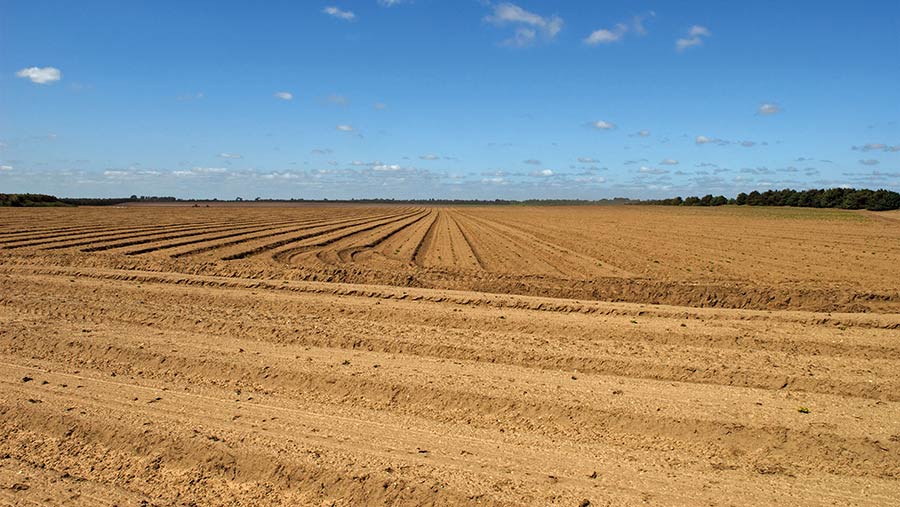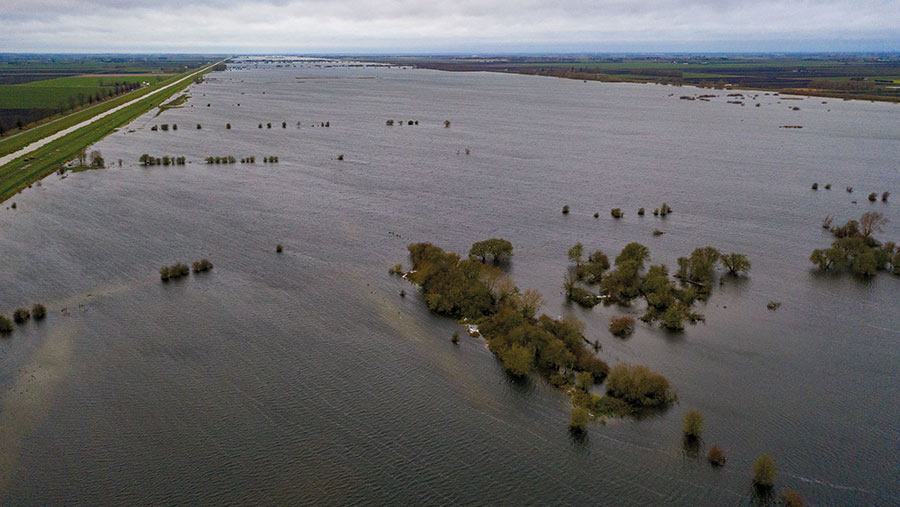The bold plan to manage scarce water resources in UK’s driest region
 © Clynt Garnham Agriculture/Alamy Stock Photo
© Clynt Garnham Agriculture/Alamy Stock Photo A groundbreaking plan for the UK’s most drought stressed region aims to help secure a fair share of water for farmers, businesses and the general public.
Not-for-profit organisation Water Resources East (WRE) has been tasked by the government to produce a long-term water resources plan for eastern England. It will include water for irrigation, energy production, transport and the general public.
WRE managing director Daniel Johns says: “It’s the first time anyone has set out for the east of England exactly how much water the region uses at the moment, how much water will be needed in the future – and where that water might come from.”
Action is needed by all sectors, not just agriculture, to manage water in a region classed as seriously water stressed by the Environment Agency, says Mr Johns.
Parts of East Anglia, for example, receive less rainfall than Greece.
“We can see from recent events – drought as well as flooding – that climate change is taking hold. It is now starting to grip the east of England and making the situation worse, so the water that we have today, we won’t have in future.
Key region for irrigation
More than 60% of the country’s irrigation abstraction licences are in eastern England, where farmers manage 75% of the region’s land.
Currently, 85% of the water abstracted from the environment is used to produce water for public supply.
The predominant users of the remaining 15% are the agri-food and energy sectors, both of which are of national and regional significance.
Even though the volumes may seem small compared with water abstracted for the public supply, Water Resources East says they have particular relevance because food and power are needed to sustain local communities and the economy.
“There are also important time- and location-related issues that need to be taken into account, which can be masked by regional and annual averages,” it says.
“Water for irrigation will have an impact on a particular catchment and is needed at specific times of the year.
“Moreover, there is increasing need to supply agriculture with water to provide environmental benefits and support national policies.”
Eastern England – the numbers
- Covers 27,000sq km*
- Two-thirds of average national rainfall
- Population of 10.5 million and rising
- Grows 40% of England’s vegetables
- Has three of the UK’s five fastest-growing cities
- 125 miles of waterways
- 30% of land mass below sea level
Source: Water Resources East
*From the Humber in the north to Basildon in the south, and from the east coast to Northampton
Consultation
Published in November 2022, the draft regional water resources plan is open for consultation until February. A final plan will be set out in autumn 2023.
Separate plans are being devised for other English regions facing their own challenges.
In eastern England, water abstraction for agriculture will, in some cases, need to be replaced with water from more sustainable sources.
This will hopefully ensure farming needs continue to be met alongside those of an expanding regional population.
“The growing need for water for irrigation will outstrip the extra water needed for housing growth,” says Mr Johns.
This could be good for the regional economy – but only if the challenge of water availability is resolved.
As climate change results in longer, hotter and drier growing seasons, it might be good for food production, he adds. “It could increase yields – but only if there’s sufficient water to not constrain that growth.”
This means access to water will have to increase.
What water there is will have to be used more efficiently – including rainwater harvesting, trickle irrigation, water storage and growers working together to share water, with changes in farm management.
Depending on their rotation and the season, some growers might need lots of water in one year but not in another – making sharing abstraction rights and irrigation resources within the same catchment increasingly common.
Shared abstraction
“There might be a series of storage reservoirs linked together so farmers can move water to that local area,” says Mr Johns.
Growers might submit bids depending on their water requirements and have a shared abstraction licence within a local area, he adds.
Other solutions are likely to involve so-called grey infrastructure, including nature-based approaches to increased water retention, capturing rainwater, storing it within the landscape and then using it to recharge aquifers.
“Rather than allowing water to run off land, straight into local rivers and then into the North Sea, we need to capture more rainfall, store it and then use it for farming as well as for the public water supply.”
Nature-based approaches are already being considered for Wensum and Yare catchments, both of which face particular water resource challenges, including nutrient neutrality and water quality issues.
These could include woody dams, infiltration systems and reconnected floodplains to slow the flow of water out to sea and retain it within the landscape in a way that is good for wildlife, biodiversity and the environment, as well as for agriculture.
Doing so will make agricultural businesses more resilient to drought, says Mr Johns. This will also improve their bottom line and land values, which are in part related to abstraction licences and yield potential.
“The earlier farmers start looking to the future, the more chance they have of sustaining their business, making it more resilient and being able to secure the water they need for their crops.”
This could prove invaluable for growers in counties such as Norfolk and Suffolk, which have the same annual rainfall as Greece, explains NFU national water resources specialist Kelly Hewson-Fisher.
Challenges
“Not many people realise the sort of challenges growers face,” she says.
“We saw exactly that during the 2022 drought. In this country, we have too much rain in some places and not enough in others.
“Rain seldom falls where we need it, and this is about planning and looking to the future – taking everything into account to ensure that we build that water resources resilience into our businesses.”
When it comes to access to water, the NFU wants government and policymakers to put agriculture and food production on the same playing field as the environment, adds Mrs Hewson-Fisher.
“We’re looking to protect and enhance the environment, but we’re also looking to protect food production and ensure that it meets the needs of a growing population.
“That is going to be even more of a challenge with climate change.”
It is about working together within the agricultural sector, and with other organisations too, including via Water For Food Group, an independent forum that aims to raise the profile of water for food production and ensure it is seen as an essential need.
Steve Moncaster, technical adviser for the Broadland Agricultural Water Abstractors Group (BAWAG), is also working to get a fair deal for farmers.
Climate change means abstraction is under increasing pressure in north-east Norfolk, he says.
“Environmental needs become more of a driver of regulation around water abstraction, and farmers are increasingly finding they have to respond to that. But it is not a core business for growers, so there is quite a bit of learning involved – there’s lots to do.”
Legislation aimed at switching from abstraction licences to permits will be a game-changer for growers, says Mr Moncaster. “It really gives the Environment Agency teeth to move towards sustainable abstraction.”
Farmers will have to up-skill, says Mr Moncaster, becoming water resource management planners and drought planners so they understand how to get the best out of the limited water resources they have.
“There is a big technical agenda that farmers must embrace. Growers also need to work together to find solutions. The more they are able to collaborate, the more options they will have and the cheaper it will be.
“Behavioural culture is a big part of what we need to change. People are already working together in clusters, but ultimately this will involve shared infrastructure.
“It will feel different and the scale will be different, too. There is a lot of work to do. It is about being prepared for what’s coming.
“We’ve all got to be like Scouts – be prepared because we know it’s coming. We have got to get our act together,” he says.
Case study: Uncertainty is our ‘biggest challenge’
Contract farmer Tim Papworth grows a range of crops for 20 landlords across north-east Norfolk. These include cereals, oilseeds, sugar beet, potatoes and vegetables; he has some grazed livestock, too.

Tim Papworth © Richard Stanton
Water scarcity poses a huge challenge, says Mr Papworth. “Last year, when we had a significant drought, we irrigated everything we could reach with water – mainly cereals, sugar beet and potatoes.
“Without that water supply, our crops would have yielded much less and the quality wouldn’t have been as good. And even with the water, our yields were down on what they would normally be. Unfortunately, we need water desperately.”
Mr Papworth says his biggest challenge is uncertainty over access to water.
“I reapplied for my irrigation licences back in 2017 and I am still waiting for the Environment Agency to confirm that I am going to have them or whether they are going to be reduced.”
For the time being, Mr Papworth has been irrigating under a limited extension of licence validity, which means he can continue irrigating, but doesn’t know whether he will have a licence in the future.
“It’s very frustrating to be in a situation where we can’t plan our business going forward. It’s been like this for six years.
“They need to get their act together and let us know whether we have a licence or not.”
Flood management provides opportunities for farmers
With large parts of the region below sea level, eastern England faces a significant threat from both flooding and drought.
Widespread floods in December 2020 affected 120 settlements, with more than 350 properties flooded, prompting the establishment of the Norfolk Strategic Flooding Alliance two months later.

© Geoff Robinson/Shutterstock
Chaired by farmer and former head of the British Army Lord Dannatt, the alliance brings together 36 risk-management authorities, companies, organisations and other bodies with responsibility for water management in the county.
Some £80m is needed to tackle flooding in Norfolk alone, says Lord Dannatt.
Farmers are among those who have a key role to play when it comes to watercourse management, including keeping rivers and culverts clear, he adds.
“Once you start unlocking local knowledge, you can unbundle a lot of the problems at the heart of flooding issues,” he says.
Local councils have a part to play, but so do landowners and homeowners. “We must recognise that water, which can be regarded as a problem because it constitutes a flood, is something we need.
“We have to adopt measures that can dilute the problem of flooding, but also retain water so it is available when we need it.”
Farmers in flood-risk areas should reflect on their own circumstances, says Lord Dannatt, such as the potential to capture water and use it for agricultural purposes.
“On our farm, we have quite a number of flood meadows designed to take excess water,” he says.
“Parts of our farm are flooded routinely in conjunction with the local authority, which has now put in a flood lagoon.
“I’m thinking of growing vines for grapes on the adjacent field. The water from that lagoon could be used to irrigate the vines. Once you start to think innovatively and differently, there are often ways you can improve your circumstances.”

